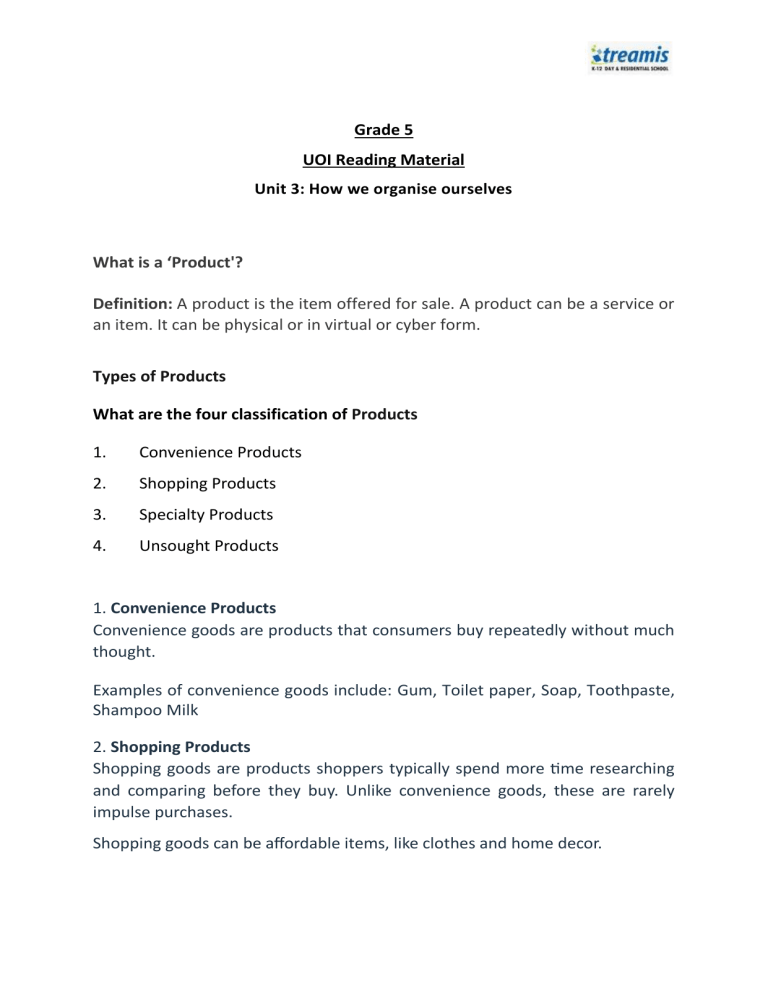
Grade 5 UOI Reading Material Unit 3: How we organise ourselves What is a ‘Product'? Definition: A product is the item offered for sale. A product can be a service or an item. It can be physical or in virtual or cyber form. Types of Products What are the four classification of Products 1. Convenience Products 2. Shopping Products 3. Specialty Products 4. Unsought Products 1. Convenience Products Convenience goods are products that consumers buy repeatedly without much thought. Examples of convenience goods include: Gum, Toilet paper, Soap, Toothpaste, Shampoo Milk 2. Shopping Products Shopping goods are products shoppers typically spend more time researching and comparing before they buy. Unlike convenience goods, these are rarely impulse purchases. Shopping goods can be affordable items, like clothes and home decor. 3. Specialty Products A specialty good is the only product of its kind on the market. This means consumers don't usually feel the need to compare and deliberate as much as they would with shopping products. For example, iPhones are a specialty good because of Apple’s strong brand identity, unique features, and operating system. This combination creates a perception of product quality. Other examples of specialty goods include luxury cars, gourmet food brands, and designer clothing. 4. Unsought Products Unsought products are goods that people aren't usually excited to buy. These products have utility, but they're usually not fun purchases. Good examples of unsought goods include fire extinguishers, insurance, and refrigerators. Why the Classification of Products Is Important? Customer Awareness Product classifications can help you better understand what motivates people to make a purchase. That information helps your team make more effective decisions for: Marketing Pricing Sales Distribution ___________________________________________________________ What Are Raw Materials? Raw materials are materials or substances used in the primary production or manufacturing of goods. KEY TAKEAWAYS Raw materials are the input goods or inventory that a company needs to manufacture its products. Examples of raw materials include steel, oil, corn, grain, gasoline, lumber, forest resources, plastic, natural gas, coal, and minerals. Raw materials can be direct raw materials, which are directly used in the manufacturing process, such as wood for a chair. Indirect raw materials are not part of the final product but are instead used comprehensively in the production process. Types of Raw Materials Raw materials can be classified in several ways, but one common classification is the nature of how the good is extracted. These types include: Mined raw materials extracted from the earth, such as ores, stones, metals, minerals, lime, sand, soil, oil, and coal. Plant-based raw materials come from trees or plants, including fruits, nuts, flowers, vegetables, resins, wood, cotton, and latex. Animal-based raw materials are extracted from animals such as milk, meat, furs, leather, and wool. What Are Raw Materials in Food? Raw materials in food can be standalone items like meats, milk, fruits, and vegetables. They can also refer to the ingredients that go into a food item or recipe. For instance, milk is a raw material used in the production of cheese and yogurt.



